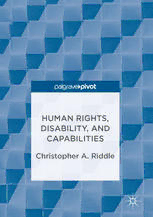
Human Rights, Disability, and Capabilities PDF
Preview Human Rights, Disability, and Capabilities
Human Rights, Disability, and Capabilities ChristopherA.Riddle Human Rights, Disability, and Capabilities ChristopherA.Riddle UticaCollege Utica,NewYork,USA ISBN978-1-137-59992-6 ISBN978-1-137-59993-3(eBook) DOI10.1057/978-1-137-59993-3 LibraryofCongressControlNumber:2016955698 ©TheEditor(s)(ifapplicable)andTheAuthor(s)2017 This work is subject to copyright. All rights are solely and exclusively licensed by the Publisher,whetherthewholeorpartofthematerialisconcerned,specificallytherightsof translation, reprinting, reuse of illustrations, recitation, broadcasting, reproduction on microfilms or in any other physical way, and transmission or information storage and retrieval,electronicadaptation,computersoftware,orbysimilarordissimilarmethodology nowknownorhereafterdeveloped. Theuseofgeneraldescriptivenames,registerednames,trademarks,servicemarks,etc.inthis publicationdoesnotimply,evenintheabsenceofaspecificstatement,thatsuchnamesare exemptfromtherelevantprotectivelawsandregulationsandthereforefreeforgeneraluse. Thepublisher,theauthorsandtheeditorsaresafetoassumethattheadviceandinformation in this book are believed to be true and accurate at the date of publication. Neither the publishernortheauthorsortheeditorsgiveawarranty,expressorimplied,withrespectto thematerialcontainedhereinorforanyerrorsoromissionsthatmayhavebeenmade. Coverillustration:AbstractBricksandShadows©StephenBonk/Fotolia.co.uk Printedonacid-freepaper ThisPalgraveMacmillanimprintispublishedbySpringerNature TheregisteredcompanyisNatureAmericaInc. Theregisteredcompanyaddressis:1NewYorkPlaza,NewYork,NY10004,U.S.A. ForMarissa,withoutwhomIwouldforgettonottakethingssoseriously all thetime. You neverfail to make melaugh,and you’realways willingto sharea pizzaatmidnight. A CKNOWLEDGMENTS This book began as a series of lectures presented at the University of Siegen in January of 2015. The first debt of gratitude I owe is thus to the organizers of the symposium and attendees at a workshop I attended while there: John Stewart-Gordon, John-Philippe Cobbaut, Jerome Bickenbach,Johann-ChristianPõder, andPetrFrantik. The material on the special importance of health and disability was the subject of presentations at the University of Quebec at Montreal and HokkaidaUniversity in Japan. ThematerialondefiningdisabilitywaspresentedtoaudiencesatAERA in SanFranciscoandat ConcordiaUniversity inMontreal. I know I have not answered all of their questions and concerns but I sincerelyappreciatethecareandattentionofeveryonewhotookthetime to offertheirinsightsand expertiseintomywork. Joshua Turner provided excellent research assistance for which I am grateful. Asalways,Iamgratefultomyfamilywhohasvettedmostofmyideasin many different, and not always academic, ways. Joya and Marissa make every day interesting and amazing. It is to Marissa that this book is dedicated. Earlier versionsof the materialhave appearedin printasfollows: DisabilityandJustice:TheCapabilitiesApproachinPracticebyChristopher A.RiddleCopyright©2014.UsedbypermissionofRowman&Littlefield PublishingGroup.Allrightsreserved. vii viii ACKNOWLEDGMENTS Riddle,C.A.“NaturalDiversityandJusticeforPeoplewithDisabilities.”In DisabilityandtheGoodHumanLife,editedbyJeromeBickenbach,Franziska Felder, and Barbara Schmitz, 271–299. Cambridge: Cambridge University Press,2014.©CambridgeUniversityPress2014.Reprintedwithpermission. Medicine, Healthcare, and Philosophy, “Defining Disability: Metaphysical Not Political,” 16 no. 3, 2013, 377–384, Christopher A. Riddle (original copyright notice as given in the publication in which the material was originallypublished).WithpermissionofSpringer. Topoi,“Well-BeingandtheCapabilityofHealth,”32no.2,2013,153–160, ChristopherA.Riddle(originalcopyrightnoticeasgiveninthepublicationin whichthematerialwasoriginallypublished).WithpermissionofSpringer. Christopher A. Riddle, “The Ontology of Impairment: Rethinking How WeDefineDisability,”inEmergingPerspectivesonDisabilityStudies,2013, PalgraveMacmillan.ReproducedwithpermissionofPalgraveMacmillan. C ONTENTS 1 Introduction 1 2 Declarations,Covenants, andConstitutions 5 3 DisabilityandHealth 11 4 TheSpecial Moral Importanceof Health 31 5 HumanRightsandCapabilities 47 6 Conclusion 65 Bibliography 67 Index 71 ix CHAPTER1 Introduction Abstract InthischapterIsetouttoexpresstheurgencyassociatedwitha project designed to ensure the upholding of a human right to health by promoting justice for people with disabilities. An emphasis is placed on howubiquitousdisabilityisinourworldandhowdamagingtheeffectsof disablingbarrierscanbeonindividuals’lives.Thegoalofthischapteristo brieflyoutlinehowI proceedthroughthe remainder ofthe book. Keywords Disability (cid:1) Justice (cid:1)Human rights More than one billion people in the world are said to be living with a disability.Approximately13.5%ofourpopulationisdisabled,andnearly 200 million of these people experience difficulty in functioning.1 This statistic fails to take into account the large number of people living with disabilitieswhorefusetodisclosethepresenceofimpairmentoutoffearof stigmatization or worse, blatant discrimination. If this number appears startling,consider thattheprevalenceof disabilityison therise andthus, this number is only likely to grow in the near future. Our population is aging,andassuch,morepeoplewillbecomedisabled.2Whenpairedwith increasingratesofeconomicinequality,illhealthanddisabilityarebound to appear more frequently. Inspired by Engels’s early observations of the working conditions of the people of England, I have previously argued that “education, income, and a wide variety of other factors contribute ©TheAuthor(s)2017 1 C.A.Riddle,HumanRights,Disability,andCapabilities, DOI10.1057/978-1-137-59993-3_1 2 HUMANRIGHTS,DISABILITY,ANDCAPABILITIES to the overall bodily health of an individual.”3 When we acknowledge bothhowmanypeopleinsocietyareforcedtoliveindestitution,aswellas the socialdeterminantsof health,there isgoodreason forgreatconcern. Theseobservationsandtheresultingconcernsitattheheartofthisbook. I argue that the widespread presence of disabling barriers and poor living conditionsresultinginbadhealtharenotsimplyconcernsofjustice.Surely theeconomicinequalitiesthat resultindisabilityorstemfromitspresence areissuesofjustice.Thatsaid,Itaketheseandothersimilarinjusticestobe special cases of justice. I take the high levels of untreated impairment and the disabling barriers present in society to constitution a special kind of inequality: a violation of human rights. I argue that when conceptualized properly,weoughttoregardthepresenceofdisablingbarriersasahuman rightsissue,tobeaddressedwithalltheseriousnessthataccompaniesmore commonandlesscontestedhumanrightsviolations. Part of the aim of this book is to produce an account of human rights that is rich enough to capture the need expressed by those living with disabilities,whilealsorootingaclaimtohumanrightswithinamuchwider concern for justice. Thus, more broadly, I aim to defend the capabilities approach to justice as being an ideal answer to Economist Amartya Sen’s compelling question: “Equality of what?”4 While I have previously been critical of this understanding of justice, I nonetheless remain convinced that it is the strongest conceptualization offered.5 I suggest that any adequate conception of justice must be capable of acknowledging that a subset of justice-based rights exist, and must be rooted in principles that defendtheprioritizationanddefenseofthesehumanrights. I set out to achieve this end in the following manner. In the second chapter, “Declarations, Covenants, and Constitutions,” I examine the historical basis for considering disability a human rights issue. I explore thedevelopmentoflegislationdesignedtopromoteandprotecttherights of peoplewithdisabilities. In“HealthandDisability,”Idefendtworelativelycontentiousclaims. First, that disability is best viewed as an interaction between impairment and disabling barriers. Second, that when properly conceptualized, dis- abilityandhealthcanberegardedsimilarly.Isuggestthatdisabilityought to be regardedasa decrementinhealth. In the next chapter, “The Special Moral Importance of Health,” I advance the claim that ill health or the presence of disabling barriers shouldbeofspecialconcern.Isuggestthatillhealthresultsindisadvantage thatdiffersnot onlyindegree,but intype,fromother injustices.Inshort,
